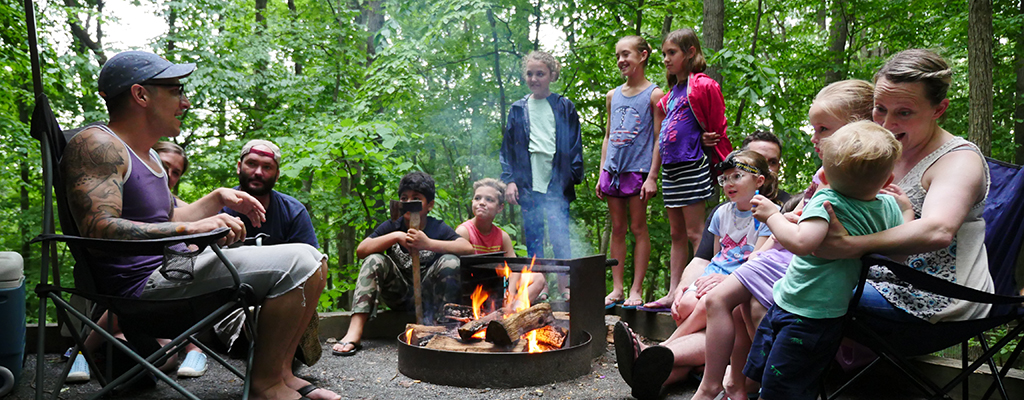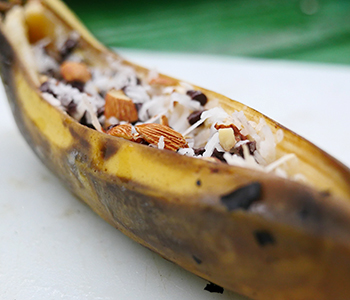What’s Cooking? An introduction to outdoor cuisine

Campfire; by Stephen Badger
Hot Dogs? Hamburgers? Those are for amateurs! A great outdoor experience can be made much more enjoyable by a simple shift in table fare.
For a great many of us, there’s a special significance to cooking outside, a primal need to put food to flame. For some, that desire persists year-round; for others, it’s the summer months that beckon most. Regardless of the drive, the process and the resulting meal often serve as the foundation of some of our fondest memories.
One of the biggest obstacles to outdoor cooking is heat control. Gas grills are known for precision and consistency, charcoal for portability and flavor, and for camaraderie, a wood fire can’t be beat. A simple internet search will yield countless recipes tailored for each. Whichever you choose, be sure to have a plan and the right tools on hand to keep things safe.
Let your imagination be your guide; there’s no limit to the amazing times you can share with family and friends.
|
Toppings are optional, of course, but some of my favorites include: Pizza sauce/olive oil, white clam sauce, fresh or shredded mozzarella, parmesan, ricotta, asiago, sliced tomatoes, olives, onions, spinach, arugula, sweet peppers, mushrooms, green onion, broccoli, pepperoni, sausage, bacon, chicken, crabmeat |
Perfect pizzas
If you want to really wow a crowd, consider an outdoor pizza bar. Lay out a vast swath of delicious toppings and let your guests choose their favorites. Nearly endless variety, quick cooking time and ease of sharing all come together in this recipe for success.
Pizzas are easiest to prepare on a gas grill at 500-700 degrees Fahrenheit. Charcoal grills work as well but slowly dwindling heat will provide for fewer pizzas.
A pizza stone placed atop the cooking grate promotes even cooking. A flat-edge baking sheet works well to get pizzas on and off the grill if cooking screens or a pizza peel isn’t available.
The ingredients are pretty simple: fresh pizza dough, a bit of all-purpose flour or cornmeal, pizza sauce and toppings. For white pizza, trade the sauce for olive oil.
Start by portioning out the dough and stretching to desired size. Work on a flat surface dusted with all-purpose flour or cornmeal to prevent sticking. A smooth, thin crust will cook quickly and evenly. When finished, transfer to a dusted, flat-edge baking sheet, cooking screen or pizza peel.
Allow guests to choose desired toppings. Carefully slide uncooked pizza onto stone and cover the grill. Check after one or two minutes. Pizza is done when crust is golden brown and cheese is hot and bubbly.
Scrape excess flour or cornmeal off stone between pizzas.

Island fever; by Stephen Badger
Campfire confections
The great majority of our readers have no doubt enjoyed the culinary bliss and simplicity of s’mores, but if you want to branch out a bit, toss your roasting stick into the fire and grab some foil—it’s time to get a bit closer to the coals.
The banana boat is a dessert that is equal parts easy and delicious. A twist and turn here or there and you can even serve them for breakfast!
Preparation again varies by individual taste, but here are a few ideas to get started:
Island Fever: Dark chocolate chips, shredded dried coconut, almonds.
Bananas Foster: Butterscotch chips, cinnamon chips, light brown sugar, chopped walnuts, whipped cream.
The Elvis: Butterscotch chips, peanut butter chips, crumbled cooked bacon, crumbled graham crackers.
But We Need S’mores: Milk chocolate chips, mini marshmallows, crumbled graham crackers.
Breakfast Banana: Blueberries, maple syrup, whipped cream.
Start by placing a ripe, banana on a cutting surface, tips up. Slice it lengthwise down the center, through the banana, but not through the lower peel. Carefully spread the sliced banana halves apart, cautious to keep the rest of the peel intact. If desired, carefully slice banana into smaller chunks or mash gently with fork. Stuff with your favorite goodies and wrap in parchment paper, then aluminum foil.
Use long-handled tongs to place on low-burning coals, to check for doneness and finally to retrieve your masterpiece. Your dessert is ready when the sides are no longer firm to the touch (about five minutes). Let cool for at least two minutes before unwrapping.
See what you can come up with, and of course, enjoy!
| Tools of the Trade Grills and campfires can get very hot! Be sure to stay safe and prepare with heat resistant gloves and grill appropriate tools like long-handled spatulas and tongs. Plastic utensils are a definite no! |
|
Headed to a State Park? Each campsite has a fire ring, but not all parks have fire rings with built-in grills. You should check ahead of time or bring your own grill grate so that you are prepared to cook. You can also bring a camp stove. Remember, all Maryland state parks are trash-free! That means there are no trash cans to ruin the view, or to attract flies, bees and other wildlife in day-use areas. Campgrounds have dumpsters for campers to dispose of their trash. Please do not burn your trash within your fire ring. |
| Suggested Supplies Aluminum foil, cleaning supplies, cutting board, first-aid kit, gloves, grill, long-handled spatula/tongs, matches/lighter, parchment paper, plates, utensils, trash bags, water. |
Article by Stephen Badger—public affairs officer. Appears in Vol. 21, No. 3 of the Maryland Natural Resource magazine, summer 2018.


 1-888-373-7888
1-888-373-7888 233733
233733